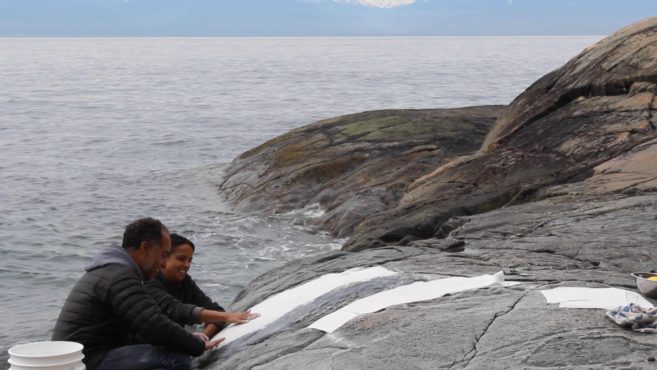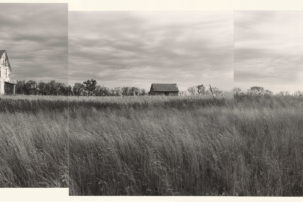In the past two years, Veronika Pausova has exhibited in New York, Monterrey, Basel, Stockholm, Prague and beyond, with an RBC Canadian Painting Competition honourable mention along the way. And it’s not hard to see why: her canvases are at once flatly graphic and richly textural, exactingly realist (in depictions of her own nail-bitten fingers) and cartoonishly simple (as in spiders rendered with a circle body and spaghetti-like legs). There are flowers and florid hues, insects and inverted colour schemes. Luxury purse handles hang out with strings of dollar-store shower-curtain rings—a deconstructed femme trilling of the hi-lo playbook.
The reference points Pausova renders—fingers, ears and feet, drapery and clothing—are both classical and conceptual, and pictured those different ways too, re-etching figure/ground binaries in unexpected ways. These Pausovian fingers (unlike the Baldessarian ones which point louchely, enigmatically) grip and hold, wrap and part: it’s no coincidence that her paintings were recently included in a Chicago exhibition called “On Anxiety.” For even if Pausova’s manner is relaxed, and her art often humorous, her paintings can also be read as sewing up a wider tension that continues to ratchet ever-higher in the Trumpian, post-truth era—even, yes, in Canada, where Pausova lives, as well as in the US, UK and Czech Republic, places where she also has ties.
Recently, on the verge of her two-person show “Busy Bodies” at Parisian Laundry in Montreal, Pausova took time to chat on the phone about her product and process. Here, in a condensed and edited version of that conversation, Pausova discusses how she started making art, what her studio process is like, why stable arts funding is so important, and what she’s up to next.
Leah Sandals: When did you first start making art? And how did you begin painting as an art form in particular?
Veronika Pausova: I was always painting and drawing as a kid. There are some drawings in my parents’ house that I feel kind of point towards what I make now. One is a drawing from when I was four years old, of a spider bride. It’s a spider with a veil, and a wedding dress. I still paint spiders.
I also have drawings of fish worlds and mermaids and beds and clocks from that time—sometimes when my dad would go to work at the MNI [Montreal Neurological Institute], I would stay in his office and draw. One time I drew him as a rat on the second floor of the building, teaching little rats—and on the fourth floor there was a person who was an ostrich, and the first floor had, I think, lizards.
Much later, I went to Glasgow School of Art where I started oil painting. I stuck to it because I liked it.
LS: Who or what would you count among your greatest artistic influences? Or who are your favourite artists or painters, and why?
VP: Right now, usually it’s my peers—so whomever I’m around. The person I’m around the most right now is Carl [Marin], my husband. We talk all the time, so he’s an influence. My friends from grad school Loie Hollowell and Amanda Baldwin are also big influences on me. Vanessa Maltese is the painter I’m most friendly with in Toronto.
Otherwise, lately, I went to the Hilma af Klint show in New York, and that was pretty amazing. I didn’t realize I was going to like it as much as I did. The colours were incredible. I also found this great book on a Czech artist: Anna Zemánková. She made drawings and watercolours of flowers, but the drawings have a sci-fi twist. She worked in her 50s, 60s and 70s, when the communists were in power. The Alex Colville the show at AGO a few years ago reminded me of Second Life and CGI. He could have done a painting of a horse or painting of a car, but it looked so contemporary.
LS: You were born in the Czech Republic. When did you move to Canada? Where are you based now?
VP: We moved from the Czech Republic when I was three years old to Montreal. I would go back every summer for a few months to be with my grandparents—that’s how I still speak Czech. When I was 16 I moved to the UK and lived there for six years. Then I moved to the US, where I did my MFA in Virginia and worked in New York. And then I moved to Toronto, where my parents moved six years ago. I am happier in Canada—it turns out health care does make you feel better! Now we don’t know where we’re going to go, because it’s all about what’s cheapest in finding a studio. Hopefully, we’ll find something in Toronto, and if not Toronto, then in Montreal.
LS: For your show at Parisian Laundry, you were in dialogue with the other exhibiting artist, Frances Adair Mckenzie. What did you discuss with Mckenzie as the show developed?
VP: We did a studio visit to start. Frances comes from an animation background and still does animation at times. Megan Bradley [the director] at Parisian Laundry said she was thinking about how we are both interested in small parts coming together, parts that you can imagine shifting or moving—it was nice to talk about that when we visited.
Frances came up with a title for our show, “Busy Bodies,” and I loved that title. I think that makes complete sense with our work: one reason is because there’s all of these little bodies that come together to make something move and express something in our work. Another reason is that we are two women artists; we are two “busy bodies.”
LS: What is your daily creative routine like? Where is your studio? What is crucial for you to have around when making artwork?
VP: When I was in Toronto, I would walk to the studio, stay in the studio for 10 to 12 hours, and then go back home. But here in Montreal, I’m at the Darling Foundry, and Carl and I are sharing a studio and living in it as well. It’s a little more intense to do everything in one space with your partner, so now I go on long walks in the morning to make it seem like I live somewhere else than I work.
In terms of other things in the studio: this might be embarrassing, but when I make very detailed parts of the canvas, I need to have some kind of bad TV show playing in the background. I can’t listen to an interesting podcast. It has to be something that I know already and that puts me into more meditative, concentrating zone—otherwise, I can’t concentrate for longer than 20-minute periods. So if I have to make 20 little spider bodies, then I really need to work steadily and, you know, put a little Frasier on.
Generally, I paint 10 to 12 hours every day until production for a show ends, and then I take a couple weeks off and start again.
LS: Do you have a sketchbook or something like it? Or some other kind of preparatory drawing or ideas process?
VP: I kind of collage a bit on Photoshop. I’ll do all the initial layers of the painting—like looser paint applied, or imprint something onto the piece, or make marks with my fingers. Then I might think more about what kind of painting it could be, and on Photoshop I can do sketches of a kind.
LS: You have had increasing success in recent years, including coverage in the New Yorker, Art in America and Art Viewer, and support from the Canada Council this year, as well as many international exhibitions. How has this increasing successes affected you and your artwork, if at all?
VP: The Canada Council [Concept to Realization] grant has probably given me the most financial stability out of everything. Because sales, you can never count on—even if it’s painting, I never know what’s going to happen with that. So ever since I got the Canada Council grant, I do feel like I can really just paint.
And other kinds of momentum are definitely good for the work too, because besides just making work towards a show, I feel like I have to be more critical of what I’m making. So I’m pushing myself harder than I was, say, three years ago.
Nice press gives me some confidence I might be on to something—but I can’t say the confidence lasts very long. I think, if anything, deadlines and financial stability are the two things that have had the most positive influence.
LS: What’s next for you?
VP: I will have a few paintings at NADA Miami with Parisian Laundry. And I’m excited I’m going to have a second solo show at Simone Subal [in New York] in May. Come December, I need to try to figure out new pieces of the body to work with—not too many fingers! Maybe ears.
LS: Well, I still think the fingers are interesting—they evoke Baldessari’s pointing hands, but also fit with the history, in painting, of drawing from life. And doing lots of life drawing as part of training to paint.
VP: It is fun to look at every finger, and pay attention to all the differences in each one. And I bite my nails, so there can be quite a few differences.
LS: Is there anything else you’d like people to know about? Or things you’ve been thinking about lately?
VP: I’ve been thinking about what happens when a painting is translated onto Instagram. The parts of my paintings that I like the most, or that I’m trying to do the most with, like differences in texture and detail—well, a lot of that gets lost on online. And it’s not just Instagram. People visit a gallery’s website more than they go to the gallery. Sometimes I’ll put a thicker layer of paint around a fly in one of my paintings, or around a finger, so you can see how the finger or the fly is stuck in the architecture. But you don’t really see that online—it just looks like one flat plane.
And, well, I just feel it’s this incredible time for women painters. I never thought I’d be living in a time when I was excited by so many things happening around me that way.
“Busy Bodies,” featuring art by Veronika Pausova and Frances Adair Mckenzie, continues to December 15 at Parisian Laundry in Montreal.







